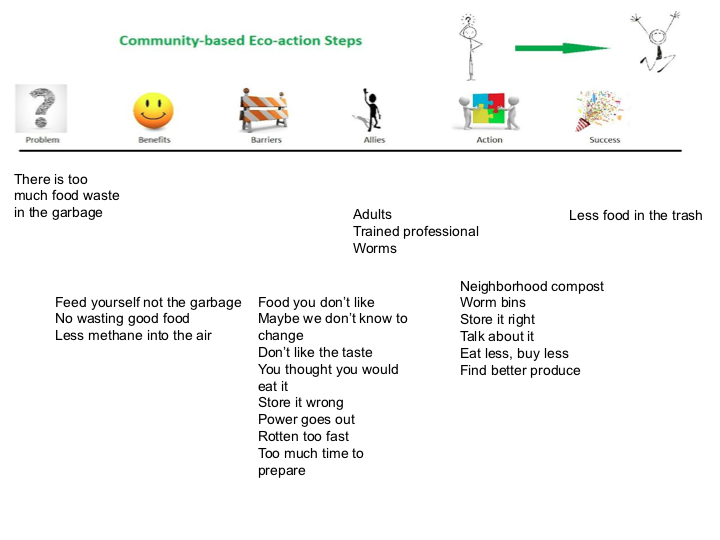Encourage ERBs
What are environmentally responsible behaviors (ERBs)? Individual or collective actions intended to conserve or restore natural environments and/or contribute towards solving or preventing environmental problems.
How do educators encourage ERBs in practice? The educator explicitly discusses or models tangible stewardship behaviors related to the program concepts, and/or elicits student ideas about their related behaviors that can help improve the environment. Educators might also lead discussions about which actions are more likely to have a positive impact on the area of focus.
Oregon Metro Waste Management and the Compost Cycle
This program for students in grades 4-7 includes synchronous and asynchronous components. Students watch three videos in preparation for the activity with an educator. Then, the educator leads students through a compost investigation and explores techniques to reduce the amount of food waste through easy eco-actions.
The educator’s synchronous lesson focuses on the importance of reducing food waste. She discusses how wasting food also wastes important natural resources like water and fossil fuels. She models tangible stewardship behaviors related to meal planning, food storage, and composting. She then suggests that students do a “waste audit” at home to figure out the types of trash they are producing and ways to reduce their waste. As the lesson concludes, the educator engages students in creating their own “eco-action” plan to reduce food waste at their school. See an example from one school below:
This lesson encourages ERBs by modeling behaviors and eliciting student ideas about locally relevant actions

This lesson encourages ERBs by modeling behaviors and eliciting student ideas about locally relevant actions
Crystal Cove State Park - Exploring Human Impacts in Tidepool Habitats and the Benefits of Marine Protected Areas
In this program, students in grades 6-12 learn about the extreme challenges tidepool organisms face on a daily basis due to human use. Students explore these human impacts and then discuss solutions while learning about California’s network of Marine Protected Areas and how they benefit these vulnerable habitats.
Throughout the program, the educator is explicit about what actions students can take to protect the tidepools and ocean animals. In this video at 6:33, an educator shows a visual and discusses (in English and Spanish) how students can protect the animals in tidepools. The program also uses this student handout with the Bingo activity below that describes specific actions that students can take to be a steward of Marine Protected Areas.
This educator explicitly discusses ERBs in her program, which is followed up with an activity that encourages students to engage in some of these actions on their own.

This educator explicitly discusses ERBs in her program, which is followed up with an activity that encourages students to engage in some of these actions on their own.
Loxahatchee River Center Oyster Reef Ecology Program
This program for students in grades 3-8 is focused on the role of oysters in the Loxahatchee River. Students discover animals that depend on oyster reefs for habitat, and learn about community efforts to rebuild reefs.
The lesson features a video clip about several oyster restoration projects completed by the Loxahatchee River District, partner organizations, and community partners. In one project, they replaced existing wood dock pilings with concrete pilings to create oyster habitat and reduce the toxic chemicals that are leached into the water from pressure-treated lumber. In another project, they restored oyster habitat underneath residential docks by using bagged oyster shells from local restaurants. The video shows student volunteers working to bag the oyster shells and install them. In the second larger scale project, the river district used rock and shell reclaimed from a beach restoration project to restore an oyster reef. The video concludes with the director of the Loxahatchee River District addressing how students can have an impact on environmental restoration efforts and the importance of working collaboratively with others.
Near the end of the program, the educator asks students how they can have a positive impact on their local environment. The educator, classroom teacher, and students discuss the following options:
- cleaning up beaches,
following fishing regulations
reducing, reusing, and recycling
respecting our environment
educating others about the environment
and being politically engaged
Teducators in this program model stewardship behaviors and get students engaged in brainstorming their own ERBs.
Wildlands Conservancy Lehigh Wildlife Program
This program teaches students about animals that live in the Lehigh River Valley. The educators show a variety of animals to students (virtually), telling their stories and explaining how people can impact the animals positively or negatively.
After introducing Bartram, a screech owl, students learn that owls are cavity nesters. The educators mention that humans don’t usually keep dead trees around, but that they can hang up a nestbox to help. She also mentions that participants might want to have screech owls around since they eat mice.
Next, she describes the problem with rodent poison. “It doesn’t always kill the mouse or rat right away. If it eats poison and goes out into a field, the poison inside of that mouse can make that owl really really sick and even kill them. It’s important to be mindful of the pest control methods that we use.” Here, she draws attention to how pesticides can have unintended consequences in the food web.
For each animal in this program, the educators make a social-ecological connection and suggest one or more ERBs that would have a positive impact on that particular species.


